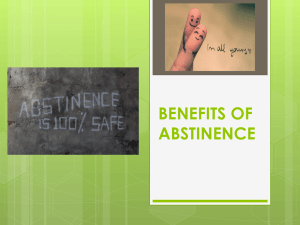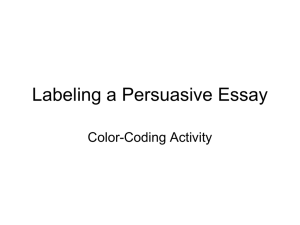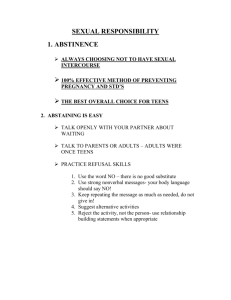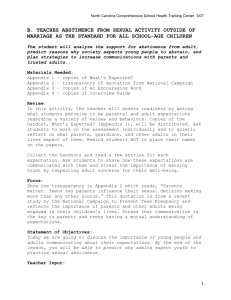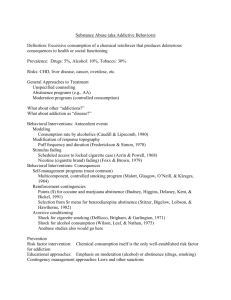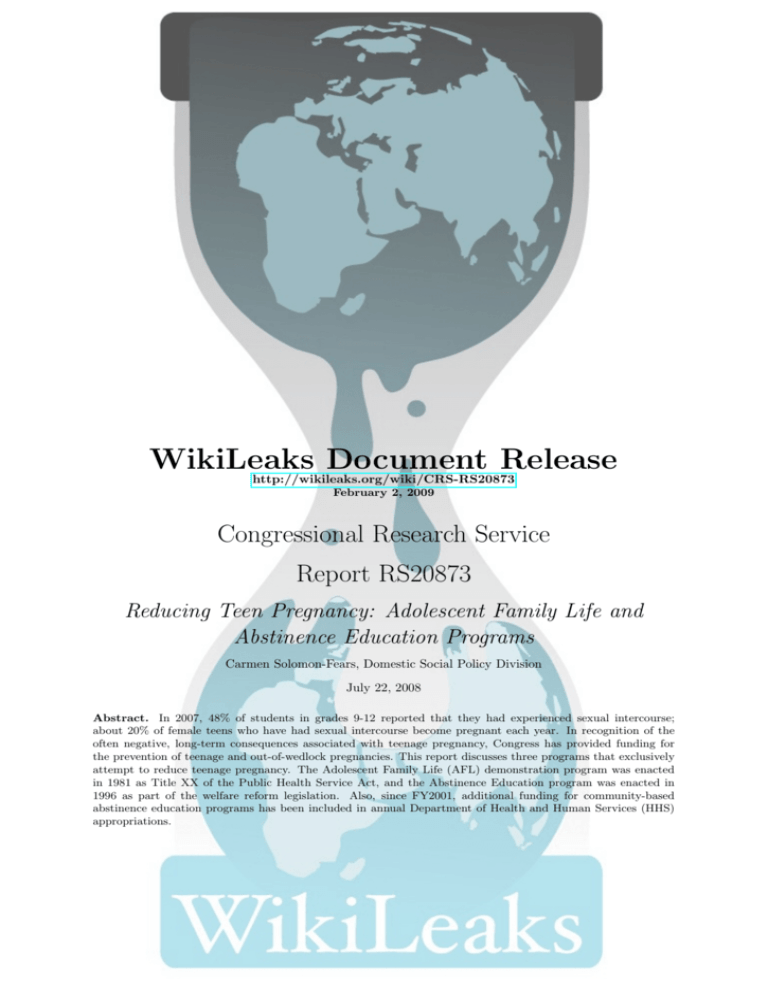
WikiLeaks
Document Release
http://wikileaks.org/wiki/CRS-RS20873
February 2, 2009
Congressional Research Service
Report RS20873
Reducing Teen Pregnancy: Adolescent Family Life and
Abstinence Education Programs
Carmen Solomon-Fears, Domestic Social Policy Division
July 22, 2008
Abstract. In 2007, 48% of students in grades 9-12 reported that they had experienced sexual intercourse;
about 20% of female teens who have had sexual intercourse become pregnant each year. In recognition of the
often negative, long-term consequences associated with teenage pregnancy, Congress has provided funding for
the prevention of teenage and out-of-wedlock pregnancies. This report discusses three programs that exclusively
attempt to reduce teenage pregnancy. The Adolescent Family Life (AFL) demonstration program was enacted
in 1981 as Title XX of the Public Health Service Act, and the Abstinence Education program was enacted in
1996 as part of the welfare reform legislation. Also, since FY2001, additional funding for community-based
abstinence education programs has been included in annual Department of Health and Human Services (HHS)
appropriations.
Order Code RS20873
Updated July 22, 2008
Reducing Teen Pregnancy:
Adolescent Family Life and
Abstinence Education Programs
http://wikileaks.org/wiki/CRS-RS20873
Carmen Solomon-Fears
Specialist in Social Legislation
Domestic and Social Policy Division
Summary
In 2007, 48% of students in grades 9-12 reported that they had experienced sexual
intercourse; about 20% of female teens who have had sexual intercourse become
pregnant each year. In recognition of the often negative, long-term consequences
associated with teenage pregnancy, Congress has provided funding for the prevention
of teenage and out-of-wedlock pregnancies. This report discusses three programs that
exclusively attempt to reduce teenage pregnancy. The Adolescent Family Life (AFL)
demonstration program was enacted in 1981 as Title XX of the Public Health Service
Act, and the Abstinence Education program was enacted in 1996 as part of the welfare
reform legislation. Also, since FY2001, additional funding for community-based
abstinence education programs has been included in annual Department of Health and
Human Services (HHS) appropriations. This report will be updated periodically.
Introduction
Since 1991, teen pregnancy, abortion, and birth rates have fallen considerably (after
14 years of decline, the teen birth rate increased from 40.5 per 1,000 females ages 15 to
19 in 2005 to 41.9 in 2006). In 2002 (latest available data), the pregnancy rate for
teenagers was 75.4 per 1,000 females aged 15-19, down 35% from the 1991 level of
115.3. The 2002 teen pregnancy rate is the lowest recorded since 1973, when this series
was initiated;1 however, it still is higher than the teen pregnancy rates of most
industrialized nations. According to a recent report on children and youth, in 2007, 33%
of 9th graders reported having experienced sexual intercourse. The corresponding statistics
1
The Alan Guttmacher Institute, U.S. Teenage Pregnancy Statistics: National and State Trends
and Trends by Race and Ethnicity, updated September 2006, p. 5.
CRS-2
for older teens were 44% for 10th graders, 56% for 11th graders, and 65% for 12th graders.2
About 20% of female teens who have had sexual intercourse become pregnant each year.
For many years, there have been divergent views with regard to sex and young
people. Many argue that sexual activity in and of itself is wrong if the persons are not
married. Others agree that it is better for teenagers to abstain from sex but are primarily
concerned about the negative consequences of sexual activity, namely unintended
pregnancy and sexually transmitted diseases (STDs). These two viewpoints are reflected
in two pregnancy prevention approaches. The Adolescent Family Life (AFL) program
encompasses both views and provides funding for both prevention programs and
programs that provide medical and social services to pregnant or parenting teens. The
Abstinence Education program centers on the abstinence-only message and only funds
programs that adhere solely to bolstering that message. (For information on Title X,
which serves a much broader clientele than teens and pre-teens, see CRS Report
RL33644, The Title X Family Planning Program, by Angela Napili.)
http://wikileaks.org/wiki/CRS-RS20873
The Adolescent Family Life Program
The AFL demonstration program was enacted in 1981 as Title XX of the Public
Health Service Act (P.L. 97-35). It is administered by the Office of Adolescent Pregnancy
Programs, Department of Health and Human Services (HHS). From 1981 until 1996, the
AFL program was the only federal program that focused directly on the issues of
adolescent sexuality, pregnancy, and parenting.3
Program Purpose. The AFL program was designed to promote — family
involvement in the delivery of services, adolescent premarital sexual abstinence, adoption
as an alternative to early parenting, parenting and child development education, and
comprehensive health, education, and social services geared to help the mother have a
healthy baby and improve subsequent life prospects for both mother and child.
Allowable Projects. The AFL program authorizes grants for three types of
demonstrations: (1) projects provide “care” services only (i.e., health, education, and
social services to pregnant adolescents, adolescent parents, their infant, families, and male
partners); (2) projects which provide “prevention” services only (i.e., services to promote
abstinence from premarital sexual relations for pre-teens, teens, and their families); and
(3) projects which provide a combination of care and prevention services. Any public or
private nonprofit organization or agency is eligible to apply for a demonstration grant.
AFL projects can be funded for up to five years. Currently (2007-2008), the AFL
program is supporting 67 demonstration projects across the country.
(See
[http://www.hhs.gov/opa/familylife/grantees/grantees.html].)
2
Centers for Disease Control and Prevention, MMWR, vol. 57, no. SS-4, Youth Risk Behavior
Surveillance — United States, 2007, June 6, 2008, available at [http://www.cdc.gov/Healthy
Youth/yrbs/pdf/yrbss07_mmwr.pdf].
3
The predecessor of the AFL program was the Adolescent Pregnancy program, which was
enacted in 1978 (P.L. 95-626). The Adolescent Pregnancy program was designed to alleviate the
negative consequences of pregnancy for the adolescent parent and her child (i.e., the care
component of the AFL program). The Adolescent Pregnancy program was consolidated into the
Maternal and Child Health Block Grant when the AFL program was enacted.
CRS-3
http://wikileaks.org/wiki/CRS-RS20873
AFL care projects are required to provide comprehensive health, education, and
social services (including life and career planning, job training, safe housing, decisionmaking and social skills), either directly or through partnerships with other community
agencies, and to evaluate new approaches for implementing these services. AFL care
projects are based within a variety of settings such as universities, hospitals, schools,
public health departments, or community agencies. Many provide home visiting services
and all have partnerships with diverse community agencies. Currently, 31 care projects
are being funded. Since 1997, all AFL prevention projects that have been funded have
been abstinence-only projects that were required to conform to the definition of
abstinence education as defined in P.L. 104-193. Most of these projects try to reach
students between the ages of 9 to 14 in public schools, community settings or family
households; all involve significant interaction with parents to strengthen the abstinence
message. Currently, 36 abstinence-only projects are being funded.4
Evaluations and Research. Each demonstration project is required to include
an internal evaluation component designed to test hypotheses specific to that project’s
service delivery model. The grantee contracts with an independent evaluator, usually one
affiliated with a college or university in the grantee’s state. The AFL program also
authorizes funding of research grants dealing with various aspects of adolescent sexuality,
pregnancy, and parenting. Research projects have examined factors that influence teenage
sexual, contraceptive and fertility behaviors, the nature and effectiveness of care services
for pregnant and parenting teens and why adoption is a little-used alternative among
pregnant teenagers. Since 1982, the AFL program has funded 68 research projects.
Table 1. Adolescent Family Life Program
(appropriations in millions of dollars)
FY
Approp.
FY
Approp.
FY
Approp.
FY
Approp.
1982
1983
1984
1985
1986
1987
1988
1989
11.080
13.518
14.918
14.716
14.689
14.000
9.626
9.529
1990
1991
1992
1993
1994
1995
1996
1997
9.421
7.789
7.789
7.598
6.250
6.698
7.698
14.209
1998
1999
2000
2001
2002
2003
2004
2005
16.709
17.700
19.327
24.377
28.900
30.922
30.720
30.742
2006
2007
2008
30.742
30.742
29.778
Abstinence Education
1996 Welfare Reform. P.L. 104-193, the 1996 welfare reform law, provided $250
million in federal funds specifically for the abstinence education program ($50 million per
year for five years, FY1998-FY2002). Funds must be requested by states when they
solicit Title V Maternal and Child Health (MCH) block grant funds and must be used
exclusively for teaching abstinence. To receive federal funds, a state must match every
4
Abstinence-only education funding under the AFL program amounted to $9 million in FY2001,
$10 million in each of the fiscal years FY2002-FY2004, and $13 million in each of the fiscal
years FY2005-FY2008.
http://wikileaks.org/wiki/CRS-RS20873
CRS-4
$4 in federal funds with $3 in state
funds.5 This means that full funding
for abstinence education must total at
least $87.5 million annually.
Although the Title V abstinence-only
education block grant has not yet been
reauthorized, the latest extension,
contained in P.L. 110-275 (H.R.
6331), continues funding for the
abstinence-only block grant through
June 30, 2009. P.L. 105-33, enacted
in 1997, included funding for a
scientific evaluation of abstinence
education programs; Mathematica
Policy Research won the contract.
(See Impacts of Four Title V, Section
510 Abstinence Education Programs,
April 2007, at [http://www.math
ematica.org/publications/PDFs/impa
ctabstinence.pdf].)
What Is Abstinence?
It is becoming clear that parents, teachers, and
teenagers are not in agreement on what
constitutes abstinence. Teens are more likely
than adults to believe that behaviors that cannot
result in pregnancy constitute abstinence.
Because pregnancy prevention together with
avoidance of STDs are dual goals of the
abstinence education program, some observers
contend that it is time for programs to explicitly
define what constitutes sexual activity. Others
contend that specifying behaviors other than
sexual intercourse violates a child’s innocence
and may provide ideas for experimentation.
Source: Lisa Remez, “Oral Sex among Adolescents: Is It
Sex or Is It Abstinence?” Family Planning Perspectives
(Alan Guttmacher Institute), 32(6), Nov-Dec. 2000, pp.
298-304.
To ensure that the abstinence-only message is not diluted, the law (P.L. 104-193,
Section 510 of the Social Security Act) stipulated that the term “abstinence education”
means an educational or motivational program that (1) has as its exclusive purpose,
teaching the social, psychological, and health gains of abstaining from sexual activity; (2)
teaches abstinence from sexual activity outside of marriage as the expected standard for
all school-age children; (3) teaches that abstinence is the only certain way to avoid
out-of-wedlock pregnancy, STDs, and associated health problems; (4) teaches that a
mutually faithful monogamous relationship within marriage is the expected standard of
human sexual activity; (5) teaches that sexual activity outside of marriage is likely to have
harmful psychological and physical effects; (6) teaches that bearing children
out-of-wedlock is likely to have harmful consequences for the child, the child’s parents,
and society; (7) teaches young people how to reject sexual advances and how alcohol and
drug use increases vulnerability to sexual advances; and (8) teaches the importance of
attaining self-sufficiency before engaging in sex.
In FY2007, all but 10 states (California, Connecticut, Maine, Minnesota, Montana,
New Jersey, Pennsylvania, Rhode Island, Vermont, and Wyoming) and several territories
sponsored an abstinence education program. Abstinence education programs launch
media campaigns to influence attitudes and behavior, develop abstinence education
curricula, revamp sexual education classes, and implement other activities focused on
abstinence education. State funding is based on the proportion of low-income children
in the state as compared to the national total. In FY2007, federal abstinence education
funding ranged from $88,501 in Alaska to $4,777,916 in Texas.
5
States use a variety of methods to meet the federal matching requirement, such as state funds,
private or foundation funds, matching funds from community-based grantees, and in-kind
services (e.g., volunteer staffing, public service announcements, etc.).
CRS-5
Appropriations History. P.L. 106-246 appropriated $20 million for FY2001 to
HHS under the Special Projects of Regional and National Significance (SPRANS)
program for abstinence-only education for adolescents aged 12 through 18. P.L. 106-554
provided $30 million for FY2002 for the SPRANS abstinence education program; P.L.
107-116 increased SPRANS program funding from $30 million to $40 million for
FY2002. The SPRANS program funding was increased by P.L. 108-7 to $55 million for
FY2003, and by P.L. 108-199 to $70 million for FY2004. P.L. 108-447 increased funding
for the SPRANS program, now the Community-Based Abstinence Education (CBAE)
program, to $100 million for FY2005. P.L. 109-149 increased funding for CBAE to $109
million for FY2006. P.L. 110-5 maintained funding for CBAE at $109 million for
FY2007. P.L. 110-161 maintained funding for CBAE at $109 million for FY2008.
http://wikileaks.org/wiki/CRS-RS20873
Issues
Comparable Funding for Abstinence Education. President Bush has
indicated his support for abstinence education. As governor of Texas, he stated: “For
children to realize their dreams, they must learn the value of abstinence. We must send
them the message that of the many decisions they will make in their lives, choosing to
avoid early sex is one of the most important. We must stress that abstinence isn’t just
about saying no to sex; it’s about saying yes to a happier, healthier future.”6 The proposal
he supported during his presidential campaign would have provided at least as much
funding for abstinence education as was provided for teen contraception services under
the Medicaid, family planning (Title X), and AFL programs, namely about $135 million
annually.7 As many as 27 other federal programs have a teen contraception component,
but expenditures solely for this component could not be isolated.8 For FY2008,
abstinence education funding totals $177 million: $50 million for the abstinence block
grant to states; $13 million for the AFL abstinence education projects; $109 million for
the CBAE program (up to $10 million of which may be used for a national abstinence
education campaign); and $4.5 million for an evaluation of the program.9
Abstinence-Only Versus Comprehensive Sexuality Education. According
to a 1997 survey, among the 69% of public school districts that had a district-wide policy
to teach sex education, 14% had a comprehensive policy that treated abstinence as one
option for adolescents in a broader sexuality education program; 51% taught abstinence
as the preferred option for teenagers, but also permitted discussion about contraception
as an effective means of protecting against unintended pregnancy and disease (an
6
Campaign literature from georgebush.com, accessed by author on November 22, 2000.
7
Some family planning experts caution that the spending data may be misleading because it
includes much more than contraception services. They contend that family planning programs
include a vast array of medical services beyond the prescription of a contraceptive method,
including pap smears, breast exams, screening for STDs, and one-on-one counseling of teens.
8
The MCH and Title XX social services block grants are among the HHS programs that provide
contraceptive services to teens (GAO/HEHS-99-4, Teen Pregnancy: State and Federal Efforts
to Implement Prevention Programs and Measure Their Effectiveness, November 1998). Also,
Temporary Assistance for Needy Families (TANF) funds can be used for such services for teens.
9
Abstinence funding: $79 million in FY2001, $100 million in FY2002, $115 million in FY2003,
$135 million in FY2004, $168 million in FY2005, and $177 million in FY2006 and FY2007.
CRS-6
abstinence-plus policy); and 35% taught abstinence as the only option outside of marriage,
with discussion of contraception prohibited entirely or permitted only to emphasize its
shortcomings (abstinence-only policy).10
http://wikileaks.org/wiki/CRS-RS20873
Advocates of the abstinence education approach argue that teenagers need to hear
a single, unambiguous message that sex outside of marriage is wrong and harmful to their
physical and emotional health. They contend that youth can and should be empowered
to say no to sex. They argue that supporting both abstinence and birth control is
hypocritical and undermines the strength of an abstinence-only message. They also cite
research that indicates that teens who take virginity pledges to refrain from sex until
marriage appear to delay having sex longer than those teens who do not make such a
commitment. (The study found that teens who publicly promise to postpone sex until
marriage refrain from intercourse for about a year and a half longer than teens who did not
make such a pledge.)11 They argue that abstinence is the most effective means of
preventing unwanted pregnancy and sexually transmitted diseases (including HIV/AIDS).
Advocates of the more comprehensive approach to sex education argue that today’s
youth need information and decision-making skills to make realistic, practical decisions
about whether to engage in sexual activities. They contend that such an approach allows
young people to make informed decisions regarding abstinence, gives them the
information they need to set relationship limits and to resist peer pressure, and also
provides them with information on the use of contraceptives and the prevention of
sexually transmitted diseases.12 They maintain that abstinence-only messages provide no
protection against the risks of pregnancy and disease for those who are sexually active.
They point out that teens who break their virginity pledges were less likely to use
contraception the first time than teens who had never made such a promise.
The April 2007 Mathematica evaluation of the Title V Abstinence Education
program found that program participants had just as many sexual partners as
nonparticipants, had sex at the same median age as nonparticipants, and were just as likely
to use contraception as nonparticipants. Supporters of the abstinence-only approach say
that the evaluation only examined four programs and is thereby inconclusive. A recent
compilation of experimentally designed evaluations of comprehensive sexual education
programs found that some comprehensive programs that included contraception
information, decision-making skills, and peer pressure strategies were successful in
delaying sexual activity, improving contraceptive use, or preventing teen pregnancy.13
10
David J. Landry, Lisa Kaeser, and Cory L. Richards, “Abstinence Promotion and the Provision
of Information about Contraception in Public School Districts Sexuality Education Policies,”
Family Planning Perspectives (Guttmacher Institute), 31(6), November-December 1999, pp. 280286.
11
Peter S. Bearman and Hannah Bruckner, “Promising the Future: Virginity Pledges as They
Affect the Transition to First Intercourse,” American Journal of Sociology, January 2001.
12
Some contend that the abstinence-only approach leads to a substitution of other risky behaviors
such as oral sex. They cite recent data that indicates that about 25% of virgin teens (15-19) have
engaged in oral sex. Source: Child Trends Data Bank. New Indicator on Oral Sex, September
15, 2005, at [http://www.childtrendsdatabank.org/whatsNew.cfm].
13
The National Campaign to Prevent Teen Pregnancy, Putting What Works To Work:
Curriculum-Based Programs That Prevent Teen Pregnancy, 2007.



